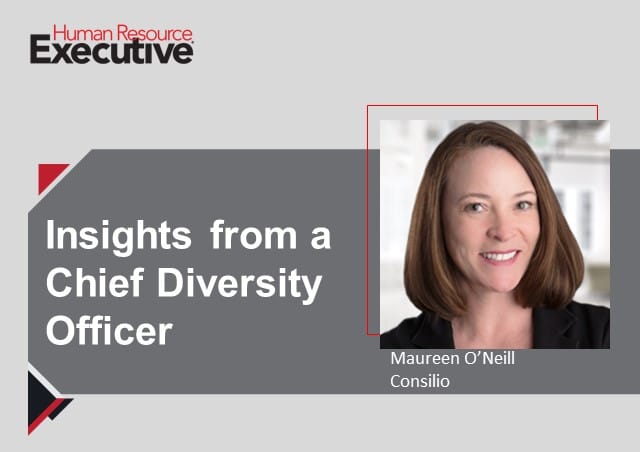It’s no secret that the tech industry suffers from a diversity problem—although it’s far from the only field lacking diverse talent. The legal profession is another where diverse talent is sorely underrepresented; for instance, according to the American Bar Association, just over one-third of practicing lawyers in the nation are women, and less than 5% are Black.
Those are realities that the HR team at Consilio is looking to change. The organization, which provides legal consulting, eDiscovery and other services, has launched a number of development and training programs—including mentoring and apprenticeships—to attract diverse, early-career talent from both the legal and tech spaces.
The intersection of those two worlds is one that Maureen O’Neill, senior vice president, client experience and diversity & inclusion officer, knows well. A practicing attorney for nearly two decades, O’Neill translated her interest in technology and data to her work at Consilio—and is now helping others with similar passions make the pivot.
O’Neill recently shared with HRE how she and Consilio prioritize DE&I in the people strategy and how other organizations can follow suit.
HRE: The tech space historically suffers from diversity challenges. Was that daunting for you when you took on this role?
O’Neill: We operate at the intersection of the technology and legal professions, and that’s another area that has historically suffered from a lack of diversity. So, it’s a dual challenge: increasing diversity in the roles focused on tech and also increasing diversity as we’re drawing from the folks coming from legal backgrounds.
HRE: What was the impetus of the mentorship program?
O’Neill: We recognize the value and importance of mentorship; it helps us retain the best talent, including diverse talent and women. I read a statistic that said employees who report an intent to stay with the company for five years or more are twice as likely as others to have a mentor. So, to increase the retention of our female and diverse employees, we recognized the need for robust mentoring programming.
We partnered with our women’s affinity group to create and roll out the mentorship program. We selected our first cohort of mentees and mentors in January of this year and the program ran for six months. We found it to be really successful, and the participants got the value out of it that we had hoped. The intent now is to run two cohorts each year. We selected the second a couple of months ago.
HRE: How is the program structured?
O’Neill: We intentionally structured the program to be small enough that we can tailor each mentorship relationship around the particular objectives and needs of the mentee. What the mentee and mentor will focus on largely depends on what each wants to accomplish. For example, a mentee who was relatively new to Consilio had an objective to broaden her network and meet more people to better understand who leads which business functions. So, the mentor’s focus was to make those introductions and to help develop that network. Other mentees have desires that might be different, so we give them the flexibility to work with their mentors to design their own experience.
HRE: Where do you see this model headed next?
O’Neill: We’ve already rolled out two other similarly structured programs. One is sponsored by our affinity group called Proud, which is our LGBTQIA affinity group. We also have a similar program launched specifically for employees located in Europe, the U.K. and Asia to give employees outside the U.S. similar opportunities to participate in mentorship. We also have a mentorship program called Consilio Leadership Academy, aimed at developing our high-potential talent and readying them for senior leadership positions at Consilio.
One of our objectives is to increase the diversity of senior leadership; our goal is for 50% of all of our CLA classes to be diverse in some respect. We’ve been fortunate to meet that goal for the first two classes.
See also: 7 talent management trends to watch in 2024
HRE: How does the apprentice program fit into Consilio’s goals around development and diversity?
O’Neill: We have two programs we characterize as apprenticeship programs. One is for project managers, who are critical to the work we do; it’s really important for us to have a strong pipeline of talent for that role. Consistent with our other objectives, we want to be sure that that pipeline of talent includes diverse employees, so we developed an apprenticeship program as a way of finding early-career talent and exposing them to a career at Consilio in project management. We feel good about our success in using the program to diversify our workforce.
The other program is what we call the Consilio Sales Associate Program. We recognize that the sales force historically has not been particularly diverse, at Consilio and throughout sales in professional services. So, our program is aimed at recruiting early-career talent from sales and also from law. We launched our first Sales Associate class this past summer and they’ll participate for a year, with the idea of stepping into client-facing sales roles. It’s similar to CLA in that we set goals for ourselves on the diversity of participants and we were pretty close to meeting them in our first class already, and we’re excited to be rolling out our next.
HRE: Given Consilio’s place in the tech and legal worlds, what is your perspective on what employers should be doing to leverage AI in a responsible, ethical way?
O’Neill: Especially when we’re talking about cutting-edge AI technologies, to me the most important thing to be concerned about is the bias that can creep into the algorithms of these tools. The tools are only as good as the information they use to learn, and if a tool is learning from an inherently biased source, the output of the tool is going to be biased. What that requires is for HR professionals and DEI professionals and lawyers to learn how to partner with the technologists creating these tools. We need to work with them to identify use cases to flag that are of concern and to understand how the technologists are keeping those biases from entering into the algorithms of these tools.
HRE: How did your own career find its way from law into the work you’re doing now?
O’Neill: I practiced law for quite a long time. I was with a large, global firm for 17 years before I made the career transition. During that time, I developed a practice in eDiscovery so I became adept at manipulating large data sets and creating extracts of data from sophisticated HR systems. So, when I decided that the law firm practice was not for me anymore, this was a natural transition. I leaned on my experience working with legal and tech and moved over to a company that provides a legal tech solution and enterprise legal services.
I think a number of my peers followed a similar career path. Part of what I’ve been trying to do with our talent pipeline is to get to those lawyers sooner—before they’ve spent a decade or two practicing law. We’re getting to the people still in law school or only a few years out and helping them see this concept that you can have an interesting, rewarding career out there, using your law degree but also using an interest in tech—and doing it in a somewhat nontraditional way.
HRE: As we near the end of the year, do you have any HR or DEI resolutions when you think about your work in 2024?
O’Neill: I would say that my—and Consilio’s, collectively—resolution for next year is to double down on this work. There’s been an unfortunate trend over the last couple of years that has been somewhat of a backlash about DEI in corporate America. And I have seen some companies pull back on this work. I am really fortunate to work for an organization that is not taking that approach. Our commitment is unwavering and, in fact, I’m especially excited that, moving into 2024, Consilio just created a new role: vice president for partnerships and communities. This role is devoted 100% to DEI work at Consilio. It’s another way that we’re making a commitment to use our resources to enable Consilio to not only do this work but to accelerate it.
Credit: Source link











